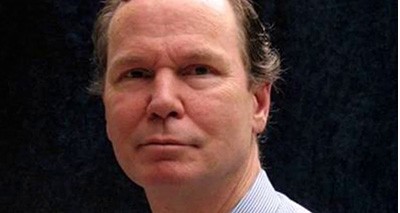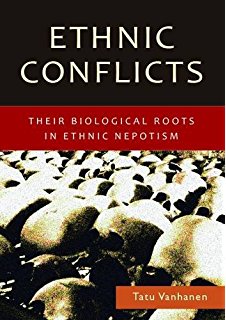A Conversation with Frank Salter
Grégoire Canlorbe, American Renaissance, October 30, 2020

Frank Kemp Salter is an Australian academic and researcher. Most of his career was at the Max Planck Research Centre for Human Ethology, in Andechs, Germany. He is best known for writings on ethnicity and ethnic interests. He studies political phenomena using conventional methods and the theories of behavioral biology. He has written about hierarchy (Emotions in Command, 1995), indoctrination (Ethnic Conflict and Indoctrination, 1998, edited with I. Eibl-Eibesfeldt), ethnic altruism and conflict (Welfare, Ethnicity and Altruism, 2002, Risky Transactions: Trust, Kinship and Ethnicity, 2004), and genetic interests (On Genetic Interests, 2003). In a review, Jared Taylor called On Genetic Interests “a vitally important contribution to our understanding of the significance of race and ethnicity in human affairs.” Dr. Salter has also been an adviser to Australia’s populist One Nation Party.
Grégoire Canlorbe: You write about the biological underpinnings of the obedience to one’s superiors in a hierarchy, especially in a bureaucracy. Please tell us more about this.
Frank Salter: In writing Emotions in Command, I observed command-giving in many organizations, from the military, to courts and parliaments, to nightclub doormen and theatrical rehearsals. The methods and observational categories were very much in the ethological tradition of Irenäus Eibl-Eibesfeldt, whom I later joined as a colleague at his Max Planck Research Centre.
I expected to find dominance, and did, but I also found friendly behavior. Effective leaders take care to soften commands and bind subordinates to them through generosity and fairness. In doing this, they are helped by what I called the “dominance infrastructure,” this being the organization’s set of rules backed by inducements and punishments. My observations confirmed part of Max Weber’s theory of bureaucracy: that it is a rule-governed hierarchy. Being rule governed, with obedience largely ensured by the dominance infrastructure, administrative positions can be filled by a wide range of personalities. Domineering behavior or brilliant leadership have negative and positive effects respectively, but are not required for the organization to function.

It was the discovery of the affiliative component of hierarchy that led me to search for an “affiliative infrastructure.” That search led me to study ethnic ties, which can bind large populations. I wanted to know if there such a thing as an “ethnic infrastructure”?
Grégoire Canlorbe: A popular claim by J. Philippe Rushton is that there are racial differences in ethnocentrism, with the least genetically heterogeneous ethnic groups being the most ethnocentric. Do you agree?
Frank Salter: Philippe Rushton’s theory was not the basis of my research into ethnic kinship. Instead, it was William Hamilton’s theory of inclusive fitness, which is generally accepted in ethology and evolutionary biology. The theory states that kinship bonds promote the reproduction of shared genes. Hamilton extended his theory to ethnic groups. I’m not aware of the finding you describe (that variations in genetic homogeneity and the degree of genetic similarity predict the level of ethnocentrism), though it has a certain plausibility. What I am aware of is that the degree of genetic homogeneity is related to solidarity, a sense of social cohesion; or, to put it differently, conflict increases when society becomes more genetically diverse. That finding, which is compatible with Hamilton’s theory, has been repeated again and again. The work of the late Tatu Vanhanen is an excellent example.
Nonetheless it seems that a more diverse society can actually lead to greater ethnocentrism: not at the level of society taken as whole, but at the level of the different ethnic components of society. As you can see in the case of America especially (and this is a universal trend in the West), white majorities are now increasingly ethnocentric, but it clearly doesn’t compare to the very high ethnocentrism of black or Latino minorities. This is an issue the media and the universities don’t understand, and never talk about.
I remember a recent interview with political scientist George Friedman, in which he agreed with the interviewer that contemporary America is based on a racial caste system ruled by a racist, ethnocentric oppressive white majority. According to this view, non-white minorities are oppressed and are free from racial feelings. The exact opposite is true. Whites are generally more individualistic and less ethnically motivated than minorities. This is evident in surveys and degree of bloc voting in elections. Europe and its settler societies score lower in collectivism than other civilizations. Those differences make multiculturalism possible, because if whites were as ethnocentric as minorities, they would quickly end affirmative action and replacement-level immigration.
My interpretation contradicts the mantras of the Black Lives Matter movement and its ideology derived from Marxist whiteness theory. They would have us believe that white societies are profoundly racist because they privilege white people. At the same time, they deny that whiteness — and by implication blackness and Hispanicness — have objective ethnic dimensions. They have no theory to explain why some minorities in the U.S. (Chinese, Japanese, Indians) have substantially higher average incomes than whites. Neither can they explain why a racist society fixated on white power would allow indiscriminate immigration policies that put whites on track to become a minority, or why such a society would accept anti-white curricula in universities and schools.
This and other messages current in the mass media and educational establishment indicate the wholesale politicization of the university system, which leads to a collapse of rationality in elite public discourse.
Grégoire Canlorbe: Is the cultural and political assimilationism of the ancient Roman empire, which neoconservative America has reproduced, a sound “group evolutionary strategy”? And what do you think Crocodile Dundee says about declining white virility in Australia or the United States?
Frank Salter: It could be argued that the Roman Empire was the outcome of the Roman group strategy, though the Empire took on a life of its own, with the adoption of imperial rule. The best work I’ve seen on the Roman Empire’s evolutionary impact is by Peter Frost and the late Henry Harpending. They argued that the Empire and Medieval states inadvertently pacified their populations genetically by executing violent men. Up to 1 percent of each generation was executed with perhaps as many dying at the scene of the crime or in prison. The European homicide rate fell steadily from the 14th to the 20th century. To use a metaphor from Crocodile Dundee, genetic pacification results in fewer and fewer interactions between men that end with the words, “that is a knife.”
As for white virility, the multicultural reality across the West since the 1970s has been that the founding ethnic group is subordinated and reduced demographically. Crocodile Dundee was played by an Anglo Australian (Paul Hogan), and Anglos have been the big losers from large-scale indiscriminate immigration introduced from the 1970s. The same is true in the United States. For Americans, one of the attractions of the film is that Mr. Dundee reminded them of their frontier ancestors: rugged, direct, masculine. He even carried a knife that resembled the one made famous by Jim Bowie.

Paul Hogan as Mick in ‘Crocodile Dundee in Los Angeles’ (Credit Image: © ZUMA Press / Entertainment Pictures / ZUMAPRESS.com)
The reality is that Australian Anglos, like American whites, are not virile, but henpecked by the nanny state. They are pecked by affirmative action. Their history is falsified in the movies. Their children are turned against them by PC history classes. They are vilified by the mainstream media. In England, their young women are raped en masse by immigrant Pakistanis. “Henpecked” is an inadequate metaphor; these pathetic nonentities are on their way to become minorities in their own homelands.
Grégoire Canlorbe: In The Biology of Peace and War, Irenäus Eibl-Eibesfeldt writes that inter-group military conflict is caused by cultural (rather than biological) evolution, even though there is a genetic predisposition for xenophobia and aggression. He says humans have a “biological filter” forbidding humans from killing others and a “cultural filter” that asks humans to kill enemies in wars. How do you assess those claims in view of the present data?
Frank Salter: I think Eibl’s core insights remain valid, though warfare needs to be distinguished from conflict. The latter occurs between individuals and groups and can occur spontaneously due to xenophobia and aggression. Warfare, on the other hand, is organized. Individual soldiers need only follow orders to kill others, and those starting wars can have a variety of motives, including aggression but also the wish to be reelected, to make a profit or to spread an ideology. Eibl was right to emphasize the inborn taboo against killing, though there is variation in this trait; there are psychopathic murderers. Classical ethology did not handle individual variation very well. Especially with Konrad Lorenz, it described “species typical” behavior.

Irenäus Eibl Eibesfeld (Credit Image: © Imago via ZUMA Press)
Eibl’s distinction between innate and culturally-directed sociality was a major contribution to behavioral biology. Lionel Tiger and Robin Fox also make this distinction in their book, The Imperial Animal. Humans are evolved for small-scale ritualized fighting and ambushes. Modern armies demand systematic killing. The traumatic effects on soldiers is only partly mitigated by modern weapons that allow killing at a distance. No wonder soldiers returning from combat often suffer Post Traumatic Stress Disorder. As a species, we are not fully evolved for this. Tiger and Fox extend this principle further. In their view, humans are not evolved to be Weberian bureaucrats who treat other humans according to a set of formal rules.
Is warfare a form of group selection and is it likely to return on a large scale? Much modern warfare is unconnected with genetic selection, whether at the individual or group levels. Napoleonic soldiers on both sides died in the millions, probably without adding to reproductive fitness, either at the individual or ethnic level. The same goes for many wars. However, I think there are exceptions. Ethnic groups contain a large number of copies of their member’s genes, which can make it adaptive for individuals to sacrifice their lives to prevent genocide or displacement. The Russian soldiers who died resisting the Nazi invasion in the Second World War saved their ethnic kin from large-scale replacement, which was Hitler’s war aim.
As for the future of warfare, it continues to be an instrument of foreign policy, though hopefully diplomatic methods for resolving conflicts will continue to develop.
Grégoire Canlorbe: In order to make sense of the traditional Chinese backwardness in science (China never produced a genius comparable to Plato, Leonardo da Vinci, or Benoît Mandelbrot), some have proposed that Chinese civilization as a “group evolutionary strategy” lacked sufficient masculine martial spirit. Yet Chinese history is full of warlike men: Xiang Yy, Xue Rengui, Mao Zedong, or Jet Li; Sun Tzu’s The Art of War is universally praised. Others evoke a lack of creativity (both at a genetic and cultural level); but Chinese food and the Hong Kong movie industry — with masters such as Tsui Hark or John Woo — are very creative. What is your view?

April 26, 2017 China’s second aircraft carrier is transferred from dry dock into the water at a launch ceremony in Dalian shipyard of the China Shipbuilding Industry Corp. (Credit Image: © Li Gang / Xinhua via ZUMA Wire)
Frank Salter: I’m optimistic about China’s scientific potential. Chinese and kindred populations have a high average mathematical IQ and a strong work ethic. What is remarkable is their delayed industrialization and low level of democratization. The evidence that China has a huge scientific potential is strong. As immigrants to democratic Western societies, they outperform whites in school and university. Their contribution to fundamental research lagged, but is growing in biomedicine and computing. It’s worth noting that Taiwan’s scientific and technical innovation are comparatively greater than those of the mainland. Culture and religion play a role. China’s relatively low inventiveness, as indicated by number of patents, is probably the result of collectivist institutions. Confucian conformity was replaced by communist conformity. Constraints on free speech have not been much relaxed with the transition to ethnic nationalism managed by a one-party state.
This relates to a matter of equity that is rarely discussed. We are seeing a large-scale transfer of intellectual property from the West to Asian nations, such as Japan, Korea, China and Taiwan. Japan and lately Korea and Taiwan have been contributing to that knowledge for several decades. That vast body of knowledge took centuries for the liberal world to develop, often at large material and human cost. (By “liberal” I mean rule-of-law and civil rights, which led to representative democracy.) That vast store of knowledge is now treated as something that should be free for all. That seems unfair. China is a regimented, undemocratic, low-wage society that has taken jobs and wealth from the West. It has not adopted the democratic and liberal institutions compatible with creativity; instead, it has been parasitic on Western liberalism. Liberalism has a price. It yields creativity and innovation, but also causes conflict and disorganization.
Is it right that China have free access to Western intellectual property? If it were feasible, it would be good to see the creative cultures of the world join together to bargain collectively with the less creative cultures. Our centuries-long investment in civil rights and democracy should be made to pay dividends.
















